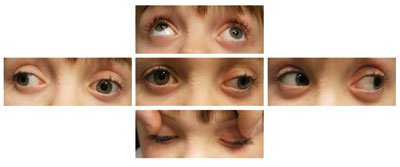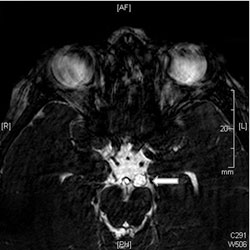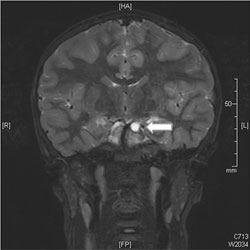Young boy referred for progressive left eye turn
Exotropia and amblyopia were found in the left eye, and the left pupil was larger than the right pupil.
 Mark E. Patron |
 Andre J. Witkin |
A 6-year-old boy was referred to the New England Eye Center for a progressive left eye turn. His parents first noticed an intermittent outward drifting of the left eye 1 year prior. An outside ophthalmologist found a 25 prism diopter intermittent left exotropia with mild amblyopia in the left eye. Extraocular motility was full.
History
The patient was initially managed with alternating patching and atropine penalization of the right eye. On 6-month follow-up, the intermittent left exotropia improved to 12 DD, but the pupil in the left eye was found to be 1 mm larger than the pupil in the right eye. The patient was prescribed “overminus” spectacles, and the anisocoria was to be closely observed.
The patient returned for follow-up 4 months later with a constant left exotropia increasing to 30 DD and a new left hypotropia of 10 DD in primary gaze. Motility examination showed mild limitations of adduction and elevation in the left eye with normal motility in the right eye. The pupil in the left eye remained 1 mm larger than in the right eye. No ptosis was noted. Given the significant change in the patient’s ocular alignment and motility, an MRI of the brain was obtained and read as negative.
The patient was subsequently referred to the New England Eye Center for further diagnosis and treatment. Additional history revealed new complaints of frequent headache over the preceding months, occasionally associated with vomiting. There was no history of significant head trauma. The patient was born full-term with an uncomplicated perinatal course. Medical history was otherwise unremarkable.
Examination
On examination, visual acuity was 20/25 in the right eye and 20/40 with pinhole improvement to 20/30 in the left eye. The patient recognized the fly, one out of three animals, and two out of nine circles on Titmus stereopsis testing. The pupils measured 5 mm with light constriction to 3 mm in the right eye and 6 mm to 5.5 mm in the left eye. Mild ptosis of the left eyelid was noted. Hertel exophthalmometry showed no proptosis. Slit lamp and dilated fundus examinations were unremarkable.
|
|
|
|
|
|
Figure 2. T2-weighted MRI showing round
hyperintense lesion along left third cranial nerve (arrow).
Images: Patron ME, Heilman CB,
Hedges TR |
|
There was a right head turn. Excursions showed limitations of upgaze and adduction in the left eye (Figure 1). Abduction seemed to be intact. Motility of the right eye was full.
A repeat MRI was obtained, showing a hyperintense lesion along the course of the left third cranial nerve on T2-weighted images (Figure 2). The left third cranial nerve appeared to be displaced laterally.

What is your diagnosis?
Left eye turn
The MRI showed a round 6-mm lesion with T2 signal qualities, suggesting an arachnoid cyst adjacent to the left third cranial nerve. The patient underwent a left orbitofrontal craniotomy with subtotal excision of the cyst. Pathological examination confirmed the diagnosis of an arachnoid cyst.
Discussion
Third cranial nerve palsies in the pediatric population are uncommon phenomena. Congenital (41%) and postnatal trauma (12%) are the most common causes in children, according to a retrospective review from the Department of Ophthalmology at the University of Pittsburgh. Tumors comprised 12% of cases with four gliomas, one lipofibroma and one unspecified brainstem tumor identified in this review. Other studies have also found infectious causes to be common.
Arachnoid cysts in specific are exceedingly rare causes of third nerve palsies, with only a few case reports in the medical literature. These lesions comprise approximately 1% of all nontraumatic intracranial masses. The cysts consist of clear fluid enclosed in reduplicated layers of arachnoid and are thought to originate from maldevelopment of leptomeninges in the prenatal or early postnatal period. These lesions are round and have a high signal in T2-weighted MRI.
As with the adult form of oculomotor palsy, clinical features in childreninclude limited adduction, elevation and depression. The involved eye shows an exotropia and hypotropia, as the lateral rectus and superior oblique muscles remain unopposed. Involvement of the levator palpebral muscle leads to ptosis. Aberrant regeneration is especially common in congenital and traumatic cases. Eyelid retraction with adduction or depression, or pupillary constriction with elevation, adduction or depression may be present.
Treatment
Treatment plans for children with third cranial nerve palsies involve treatment of amblyopia and strabismus surgery. Treatment of amblyopia can be effective in maintaining the level of visual acuity at the onset of the third nerve palsy, but improvement is difficult to achieve. Surgical treatment often results in cosmetically acceptable alignment of the eyes, but rarely results in restoration or achievement of binocular function.
Our patient, a 6-year-old boy with a progressive left eye turn that was found to be due to an arachnoid cyst of the third cranial nerve, underwent subtotal excision of the cyst. One month after surgery, he had improving third nerve function, but still had a large exotropia and amblyopia in the left eye.
References:
- Ashker L, Weinstein JM, Dias M, Kanev P, Nguyen D, Bonsall DJ. Arachnoid cyst causing third cranial nerve palsy manifesting as isolated internal ophthalmoplegia and iris cholinergic supersensitivity. J Neuroophthalmol. 2008;28(3):192-197.
- Harley RD. Paralytic strabismus in children. Etiologic incidence and management of the third, fourth, and sixth nerve palsies. Ophthalmology. 1980;87(1):24-43.
- Ing EB, Sullivan TJ, Clarke MP, Buncic JR. Oculomotor nerve palsies in children. J Pediatr Ophthalmol Strabismus. 1992;29(6):331-336.
- Schumacher-Feero LA, Yoo KW, Solari FM, Biglan AW. Third cranial nerve palsy in children. Am J Ophthalmol. 1999;128(2):216-221.
- Mark E. Patron, MD, Carl B. Heilman, MD, and Thomas R. Hedges III, MD, can be reached at New England Eye Center, Tufts University School of Medicine, 750 Washington St., Box 450, Boston, MA 02111; 617-636-4219; fax: 617-636-4866; Web site: www.neec.com.
- Edited by Mark E. Patron, MD, and Andre J. Witkin, MD. Drs. Patron and Witkin can be reached at New England Eye Center, Tufts University School of Medicine, 750 Washington St., Box 450, Boston, MA 02111; 617-636-4219; fax: 617-636-4866; Web site: www.neec.com.




